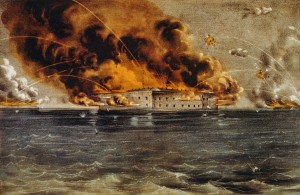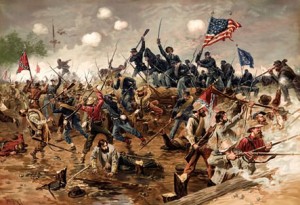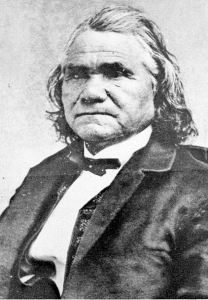
Marking the start of 150th anniversary observances of the start of America’s War Between the States, a brilliant starburst mortar shell burst at 6:45 a.m. this morning over Fort Sumter, South Carolina.
Over the next four years. reenactments and ceremonies will mark key events in the bitter civil conflict that divided our nation, ended slavery and claimed 600,000 lives in what was history’s first industrialized war – in which railways, telegraph and industry played a key role.
Some would say the war began long before the South Carolina militia opened fire on the U.S. Army inside Fort Sumpter at the mouth of Charleston, S.C., harbor on April 12, 1861.

During the presidential election of 1860, the brand-new Republican Party, led by Abraham Lincoln, had campaigned against the expansion of slavery beyond states in which it already existed – such as Kansas, California and Nevada.
Lincoln also advocated a strong federal government instead of a loosely organized affiliation of states. So, with his win at the polls, talk of civil war grew, particularly since in their 1860 platform, the Republicans explicitly denounced threats of disunion as treason. Secessionists countered that there was nothing in the Constitution requiring states to remain in the Union forever.
When news of Lincoln’s election victory spread, seven states in which slavery was practiced, South Carolina, Mississippi, Florida, Alabama, Georgia, Louisiana and Texas, announced they had withdrawn from the Union to form the Confederate States of America. The outgoing administration of President James Buchanan and the incoming Lincoln Administration challenged the legality of their action, calling it rebellion.

But it was not until 150 years ago today that the conflict turned violent. At dawn on April 12, 1861, the South Carolina militia took matters into their own hands, opening fire on Fort Sumter.
“As a boy, I remember hearing at my Aunt Annie’s knee how we told the Yankees to go home, but they wouldn’t do it,” remembers columnist Jay Tower. “So, in her words, ‘We had to shoot ‘em.’”
Lincoln responded by calling for a volunteer army from each state to recapture federal property. This led to declarations of secession by four more states – Virginia, North Carolina, Arkansas, and Tennessee – which were not major cotton producers and had resisted secession talk. The South’s top military commander, Robert E. Lee, had remained a general in the U.S. Army until the very last moment, waiting for the Virginia legislature to decide which side it would take.
Both sides raised armies as the Union seized strategic control of the slave state of Maryland – which surrounds the District of Columbia on three sides with Virginia to the south. Two slave states hesitated to takes sides – Missouri and Kentucky – where it was not uncommon for families to be torn with one son fighting for the Union and another signing up with the Confederacy.

In the West, the Dakota territories voted to go with the North. In the Oklahoma Territory, the Five Civilized Tribes voted to side with the South. The Cherokee general, Stand Watie, would be the last Confederate general to surrender at the war’s end.
The Union Navy quickly established a naval blockade of southern ports that virtually blocked cotton sales on which the Confederacy depended for income. The war ended four years later with the South in ruins and slavery abolished. The Cherokees were punished with the seizure of the Cherokee Outlet – which was then opened to homesteaders in the famous Oklahoma land runs.
Now 150 years later, Civil War reenactments are scheduled through 2015.
And it all begins today as antique cannon around Charleston harbor will continue shooting blanks at Fort Sumter in recognition of the historic bombardment that started it all.

